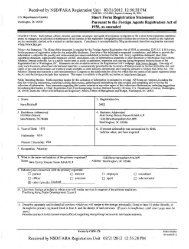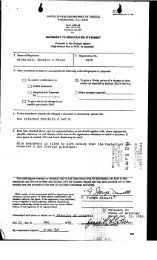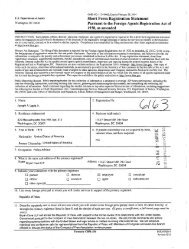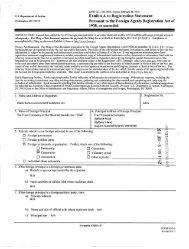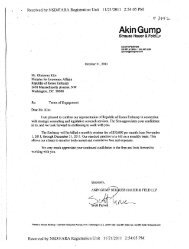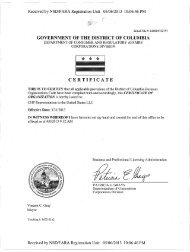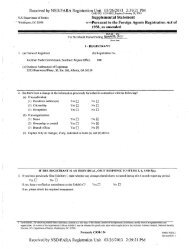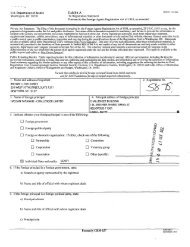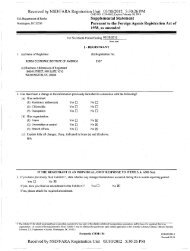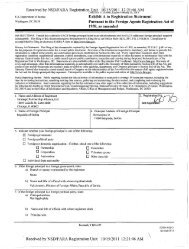Supplemental Statement - FARA
Supplemental Statement - FARA
Supplemental Statement - FARA
Create successful ePaper yourself
Turn your PDF publications into a flip-book with our unique Google optimized e-Paper software.
BE M<br />
eceived NSD/<strong>FARA</strong> Uni no 42 i M<br />
Re istration<br />
SPt. yjt<br />
^V 5>_<br />
Dolphins<br />
_•*••%<br />
• w ^<br />
SE.<br />
AJL _-51 «>^Jw-<br />
*_•£_ i*2E#*<br />
'7rf<br />
Fil-<br />
W3S-<br />
rt--<br />
T Y<br />
•csn 1B5.7.'ta.Hj'.^ V ,-<br />
•Si.<br />
,K<br />
!SW<br />
!-«<br />
s-'J<br />
CfV-qftyJgMf A*.<br />
t^V,<br />
ORE 5"><br />
These guys have quite a time of it in waters all around Tasmania. Tasmania bottle-nosed dolphins can be prevalent in Macquarie Harbour,<br />
the River Derwent, and in waters off the Tasman Peninsula and Bruny Island. The ever risible dolphin can be a regular accompaniment to<br />
tour boats cruising any of these waters.<br />
Little Penguin<br />
. The scientific name ofthe little (or fairy) penguin - Eudyptula minor - is most descriptive. Not only are these penguins the smallest of<br />
penguins, but Eudyptula means 'good little diver".<br />
The little penguin's streamlined shape and efficient flippers enable it to seek prey in shallow short dives, typically between 10 and 30<br />
.metres. Its diet consists of small fish, squid, krill (shrimp-like crustaceans) and occasionally crab larvae or sea horses from the sea floor.<br />
Some little penguins return to their burrows year round, but most stay at sea over autumn and winter. Most birds in a colony return to their<br />
burrows in small groups within an hour or so of darkness. Little penguins can be seen in a number of places around Tasmania- including<br />
Bicheno.The Neck on Bruny Island, Low Head, Lillicoe Beach in Devonport, Bonnet Island near Strahan and in parts of Burnie and Stanley<br />
- although the majority (up to 95 per cent of the birds) live on offshore islands.<br />
Whales<br />
There was a time when Hobart residents (nineteenth century) complained-of being kept awake by the sounds of whales in the River<br />
Derwent. Today, the mere report of a sighting sends a thrill of excitement through the city.<br />
During the nineteenth century the whaling industry was big business in the developing colony of Van Diemen's Land. At the peak of the<br />
boom, in the 1830s, there were enough whales in Tasmanian waters to support 32 shore-based whaling stations, from Recherche Bay in<br />
the south, to Bicheno on the east coast.<br />
There were nine whaling stations in Hobart. So great were the numbers of southern right whales in the Derwent that it was considered<br />
dangerous to cross the estuary in small boats. Today, the southern right whale is among the rarest of whales. But since the end of<br />
commercial whaling its numbers have begun to increase and whale sightings in Tasmanian waters are on the rise.<br />
Humpbacks migrate northward past Tasmania to parts of mainland Australia between May and July. They return southward along the Tasmanian<br />
coast enroute to their sub-Antarctic feeding grounds between September and November. Southern right whales migrate north along the<br />
Tasmanian coast from June to September and return southward between September and late October. A proportion ofthe population gives<br />
birth in Tasmanian waters.<br />
Most whale sightings occur on the Tasmanian east coast. Frederick Henry Bay and Great Oyster Bay on the east coast and offshore cruising<br />
are excellent vantage points for whale watching.<br />
discovertasmania.com Tasmania<br />
Received by NSD/<strong>FARA</strong> Registration Unit 05/01/2012 4:09:43 PM<br />
• _»«•*»<br />
V H




